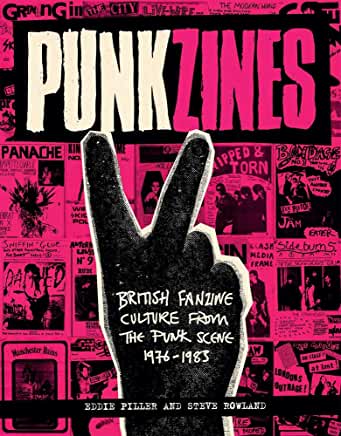Punk Zines – British Fanzine Culture from the Punk Scene 1976-1983, Eddie Piller and Steve Rowland
Omnibus Press, 14-15 Berners Street, GB-London, W1T 3LJ, www.omnibuspress.com
This one goes back to the very beginning and is a great time travel in Punk rock history. I did not know that the word „punk“ first appeared before 1575, later Shakespeare used it to describe prostitutes in a 1623 play. And in the 50‘s a american dictionary explains it is young people who fight and are involved in anti-social activity. But modern punk started 1975, depending on who you ask. More on this question interested readers find in the book. It is not only about fanzines, it also features chapters like: „The collapse of the Sex Pistols“, „Politics in Punk“, „Punks second wave“, „Bands and indie record labels“, „The Better Badges Story“ and much more.
But its main focus is on the fanzines, also a view in the history of anti-establishment magazines like Oz, International Times and Suburban Press. You learn which fanzines were the first to be published in the UK and in the USA. Seems Sniffin‘ Glue did influence a lot of the british fanzine scene in the early beginning. Many of those are introduced and the editors speak to the fanzine makers about how, when and why they started. Mostly those story’s kinda match, but that is no surprise. Great to look at the original, rare, artwork from a lot of those early zines, mostly front covers from Sniffin‘ Glue, Bondage, 48 Thrills, Punk, Jamming, London‘s Burning, Kingdom Come, Ripped and Torn, Chainsaw, Alternative Ulster, Negative Reaction, Panache, Vague Allied Propaganda and many more! It is a great read for people who are interested in the beginnings of Punk rock. For some Punk was over after six months in 1976, others still carry the torch until today. In the mid seventies it was the first time that photocopy machines became popular, so all of a sudden everyone (who had access to make free copy’s at work, or enough money to pay in a copy shop) was in the position to make a fanzine without using expensive printers that only worked out financially when many copys printed (and sold!). With xerox machines you could do like twenty and if more needed just produce more by demand. Considering that I saw my first fanzine in the early eighties it is no surprise that I‘m not familiar with any of the very early zines from the UK or the USA. Therefore it was a real interesting trip down the history lane with leading figures of the scene from that time. Like the subtitle says, this story ends around 1983. But as we all know, the story of fanzines did not end then. After that they have been made all over the world for many decades and in many formats. Like Glen Matlock once said: „Fanzines were the glue that held punk together“. That is probably still the case today, lets hope that glue does not get lost. It could mean a bitter real end for Punk as we know it. Meanwhile this is a great read if you remember the original punk zines, but of course also for younger punks who want to know about the original punk culture and history. The book looks and feels great, unfortunately most of the footers are barely to read, anyway, by now you know if you need this or not. 176 pages, paperback, 19,99 Euro (dolf)
Isbn 978-1913172138
[Trust # 211 December 2021]
